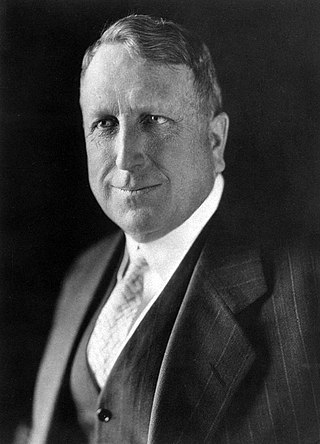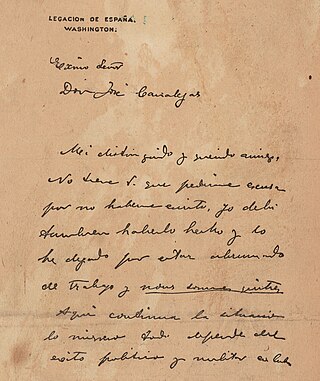Related Research Articles

William Randolph Hearst Sr. was an American businessman, newspaper publisher, and politician known for developing the nation's largest newspaper chain and media company, Hearst Communications. His flamboyant methods of yellow journalism influenced the nation's popular media by emphasizing sensationalism and human interest stories. Hearst entered the publishing business in 1887 with Mitchell Trubitt after being given control of The San Francisco Examiner by his wealthy father, Senator George Hearst.
Yellow journalism and yellow press are American terms for journalism and associated newspapers that present little or no legitimate, well-researched news while instead using eye-catching headlines for increased sales. Techniques may include exaggerations of news events, scandal-mongering, or sensationalism. By extension, the term yellow journalism is used today as a pejorative to decry any journalism that treats news in an unprofessional or unethical fashion.

The Mona Lisa is a half-length portrait painting by Italian artist Leonardo da Vinci. Considered an archetypal masterpiece of the Italian Renaissance, it has been described as "the best known, the most visited, the most written about, the most sung about, [and] the most parodied work of art in the world". The painting's novel qualities include the subject's enigmatic expression, monumentality of the composition, the subtle modelling of forms, and the atmospheric illusionism.

A newsreel is a form of short documentary film, containing news stories and items of topical interest, that was prevalent between the 1910s and the mid 1970s. Typically presented in a cinema, newsreels were a source of current affairs, information, and entertainment for millions of moviegoers. Newsreels were typically exhibited preceding a feature film, but there were also dedicated newsreel theaters in many major cities in the 1930s and ’40s, and some large city cinemas also included a smaller theaterette where newsreels were screened continuously throughout the day.

The De Lôme Letter, a note written by Señor Don Enrique Dupuy de Lôme, the Spanish Ambassador to the United States, to Don José Canalejas y Méndez, the Foreign Minister of Spain, reveals de Lôme’s opinion about the Spanish involvement in Cuba and US President McKinley’s diplomacy.

Vincenzo Peruggia was an Italian museum worker, artist and thief, most famous for stealing the Mona Lisa from the Louvre museum in Paris on 21 August 1911.

The Ten Years' War, also known as the Great War and the War of '68, was part of Cuba's fight for independence from Spain. The uprising was led by Cuban-born planters and other wealthy natives. On 10 October 1868, sugar mill owner Carlos Manuel de Céspedes and his followers proclaimed independence, beginning the conflict. This was the first of three liberation wars that Cuba fought against Spain, the other two being the Little War (1879–1880) and the Cuban War of Independence (1895–1898). The final three months of the last conflict escalated with United States involvement, leading to the Spanish–American War.
Cuban Ledge is a reef or islet composed chiefly of sand and small rocks in Eastchester Bay, the Bronx, in Long Island Sound. It is located between Rodman's Neck and Country Club in Eastchester Bay and is visible only during periods of low tide. It is a hazard to boats, and is marked with a signal tower.

Robert David Simon was an American television correspondent for CBS News. He covered crises, war, and unrest in 67 countries during his career. Simon reported the withdrawal of American troops from Vietnam, the Israeli-Lebanese Conflict in 1982, and the student protests in China's Tiananmen Square in 1989. During the Persian Gulf War in 1991, he and four of his TV crew were captured and imprisoned by Iraq for 40 days. He published a book about the experience titled Forty Days.
Eduardo de Valfierno, who posed as a marqués (marquis), was supposedly an Argentine con man who allegedly masterminded the theft of the Mona Lisa in 1911. There are serious doubts as to whether or not he existed.

The history of American newspapers begins in the early 18th century with the publication of the first colonial newspapers. American newspapers began as modest affairs—a sideline for printers. They became a political force in the campaign for American independence. Following independence the first amendment to U.S. Constitution guaranteed freedom of the press. The Postal Service Act of 1792 provided substantial subsidies: Newspapers were delivered up to 100 miles for a penny and beyond for 1.5 cents, when first class postage ranged from six cents to a quarter.

The Cuban War of Independence, also known in Cuba as The Necessary War, fought from 1895 to 1898, was the last of three liberation wars that Cuba fought against Spain, the other two being the Ten Years' War (1868–1878) and the Little War (1879–1880). The final three months of the conflict escalated to become the Spanish–American War, with United States forces being deployed in Cuba, Puerto Rico, and the Philippine Islands against Spain. Historians disagree as to the extent that United States officials were motivated to intervene for humanitarian reasons but agree that yellow journalism exaggerated atrocities attributed to Spanish forces against Cuban civilians.
Yves Chaudron was a supposed French master art forger who is alleged to have copied images of Leonardo da Vinci's Mona Lisa as part of Eduardo de Valfierno's famous 1911 Mona Lisa painting theft. In reality he may be a fictional character created by Karl Decker for an article that ran in a 1932 issue of the Saturday Evening Post, and passed off as a real person. There is also very little evidence that Valfierno actually existed, or if he did, that he was involved in the theft of the Mona Lisa at all.
"Mona Lisas and Mad Hatters" is a song written by English musician Elton John and songwriter Bernie Taupin, and performed by John. It was released on the 1972 album Honky Château. The lyrics conveyed Taupin's take on New York City after hearing a gun go off near his hotel window during his first visit to the city. The song's lyrics were partly inspired by Ben E. King's "Spanish Harlem," written by Jerry Leiber and Phil Spector, in which he sings "There is a rose in Spanish Harlem."

The Spanish–American War is considered to be both a turning point in the history of propaganda and the beginning of the practice of yellow journalism.
Rhonda Roland Shearer is an American sculptor, scholar, and journalist, who founded the nonprofit organization Art Science Research Laboratory with her late husband Stephen Jay Gould. The mission statement avows that the lab aims to "infuse intellectual rigor and critical thinking in disciplines that range from Academics to Journalism. ASRL researches conventional beliefs and misinformation and transmits its findings by means of scientific methods and state-of-the-art computer technologies."
Martene Windsor "Bill" Corum" was a sports columnist for the New York Evening Journal and the New York Journal-American, a radio and television sportscaster, and racetrack executive. He served as president of Churchill Downs for nine years, and is widely credited for coining the term "Run for the Roses" to describe the Kentucky Derby.

Evangelina Cosio y Cisneros was the focus of events that played out in the years 1896–1898 during the Cuban War of Independence. Her imprisonment as a rebel and escape from a Spanish jail in Cuba, with the assistance of the reporter, Karl Decker from William Randolph Hearst's New York Journal, created wide interest in the United States press, as well as accusations of fraud and bribery.
Rolando Sarraff Trujillo is a Cuban intelligence officer who was convicted for espionage for the United States Central Intelligence Agency.

The sources for Citizen Kane, the 1941 American motion picture that marked the feature film debut of Orson Welles, have been the subject of speculation and controversy since the project's inception. With a story spanning 60 years, the quasi-biographical film examines the life and legacy of Charles Foster Kane, played by Welles, a fictional character based in part upon the American newspaper magnate William Randolph Hearst and Chicago tycoons Samuel Insull and Harold McCormick. A rich incorporation of the experiences and knowledge of its authors, the film earned an Academy Award for Best Writing for Herman J. Mankiewicz and Welles.
References
- ↑ "KARL DECKER DIES; CORRESPONDENT, 73; Hearst Reporter Many Years Rescued Evangelina Cisneros From a Cuban Prison". The New York Times. December 5, 1941 – via NYTimes.com.
- ↑ "Not a hoax: New evidence in the New York Journal's rescue of Evangelina Cisneros". fs2.american.edu.
- ↑ "Was 'jailbreaking journalism' a hoax? Evidence points the other way". October 15, 2010.
- ↑ Beitiks, Edvins; Staff, Of the Examiner (October 12, 1999). "Cultivating legend of "White Rose'". SFGate.
- ↑ Campbell, W. Joseph (October 8, 2013). The Year That Defined American Journalism: 1897 and the Clash of Paradigms. Routledge. ISBN 9781135205058 – via Google Books.
- ↑ "80 YEARS AGO TODAY - THE BIRTH OF A PHONY MASTERMIND".
- ↑ "100 Years Ago: The Mastermind Behind the Mona Lisa Heist". 7 December 2013.